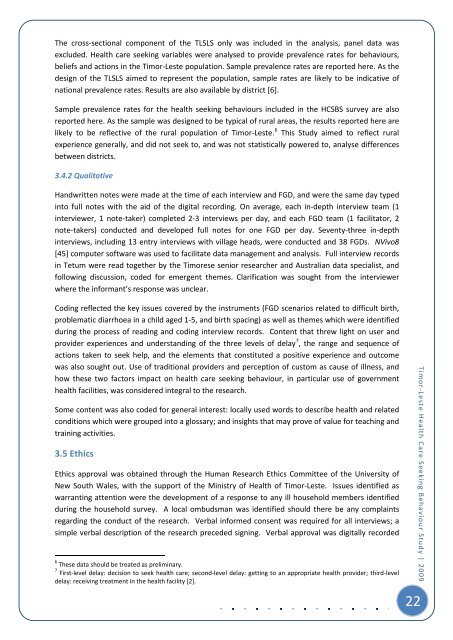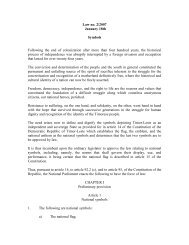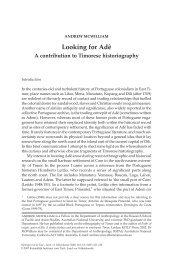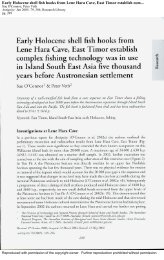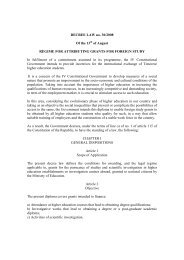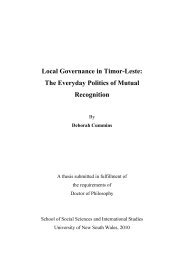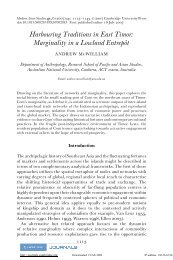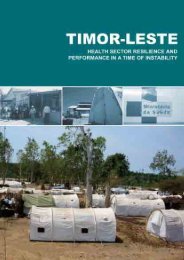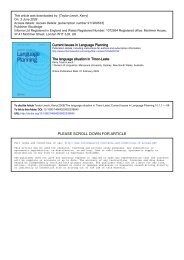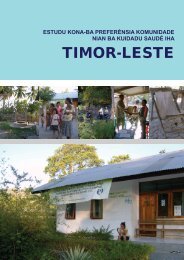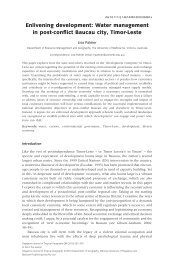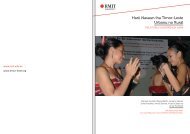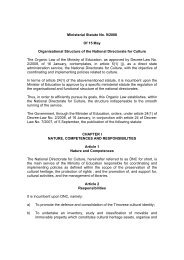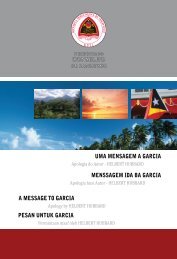Timor-Leste Health Care Seeking Behaviour Study - Secretaria de ...
Timor-Leste Health Care Seeking Behaviour Study - Secretaria de ...
Timor-Leste Health Care Seeking Behaviour Study - Secretaria de ...
- No tags were found...
Create successful ePaper yourself
Turn your PDF publications into a flip-book with our unique Google optimized e-Paper software.
The cross-sectional component of the TLSLS only was inclu<strong>de</strong>d in the analysis, panel data wasexclu<strong>de</strong>d. <strong>Health</strong> care seeking variables were analysed to provi<strong>de</strong> prevalence rates for behaviours,beliefs and actions in the <strong>Timor</strong>-<strong>Leste</strong> population. Sample prevalence rates are reported here. As the<strong>de</strong>sign of the TLSLS aimed to represent the population, sample rates are likely to be indicative ofnational prevalence rates. Results are also available by district [6].Sample prevalence rates for the health seeking behaviours inclu<strong>de</strong>d in the HCSBS survey are alsoreported here. As the sample was <strong>de</strong>signed to be typical of rural areas, the results reported here arelikely to be reflective of the rural population of <strong>Timor</strong>-<strong>Leste</strong>. 6 This <strong>Study</strong> aimed to reflect ruralexperience generally, and did not seek to, and was not statistically powered to, analyse differencesbetween districts.3.4.2 QualitativeHandwritten notes were ma<strong>de</strong> at the time of each interview and FGD, and were the same day typedinto full notes with the aid of the digital recording. On average, each in-<strong>de</strong>pth interview team (1interviewer, 1 note-taker) completed 2-3 interviews per day, and each FGD team (1 facilitator, 2note-takers) conducted and <strong>de</strong>veloped full notes for one FGD per day. Seventy-three in-<strong>de</strong>pthinterviews, including 13 entry interviews with village heads, were conducted and 38 FGDs. NVivo8[45] computer software was used to facilitate data management and analysis. Full interview recordsin Tetum were read together by the <strong>Timor</strong>ese senior researcher and Australian data specialist, andfollowing discussion, co<strong>de</strong>d for emergent themes. Clarification was sought from the interviewerwhere the informant’s response was unclear.Coding reflected the key issues covered by the instruments (FGD scenarios related to difficult birth,problematic diarrhoea in a child aged 1-5, and birth spacing) as well as themes which were i<strong>de</strong>ntifiedduring the process of reading and coding interview records. Content that threw light on user andprovi<strong>de</strong>r experiences and un<strong>de</strong>rstanding of the three levels of <strong>de</strong>lay 7 , the range and sequence ofactions taken to seek help, and the elements that constituted a positive experience and outcomewas also sought out. Use of traditional provi<strong>de</strong>rs and perception of custom as cause of illness, andhow these two factors impact on health care seeking behaviour, in particular use of governmenthealth facilities, was consi<strong>de</strong>red integral to the research.Some content was also co<strong>de</strong>d for general interest: locally used words to <strong>de</strong>scribe health and relatedconditions which were grouped into a glossary; and insights that may prove of value for teaching andtraining activities.3.5 EthicsEthics approval was obtained through the Human Research Ethics Committee of the University ofNew South Wales, with the support of the Ministry of <strong>Health</strong> of <strong>Timor</strong>-<strong>Leste</strong>. Issues i<strong>de</strong>ntified aswarranting attention were the <strong>de</strong>velopment of a response to any ill household members i<strong>de</strong>ntifiedduring the household survey. A local ombudsman was i<strong>de</strong>ntified should there be any complaintsregarding the conduct of the research. Verbal informed consent was required for all interviews; asimple verbal <strong>de</strong>scription of the research prece<strong>de</strong>d signing. Verbal approval was digitally recor<strong>de</strong>d6 These data should be treated as preliminary.7 First-level <strong>de</strong>lay: <strong>de</strong>cision to seek health care; second-level <strong>de</strong>lay: getting to an appropriate health provi<strong>de</strong>r; third-level<strong>de</strong>lay: receiving treatment in the health facility [2].22<strong>Timor</strong>-<strong>Leste</strong> <strong>Health</strong> <strong>Care</strong> <strong>Seeking</strong> <strong>Behaviour</strong> <strong>Study</strong> | 2009


